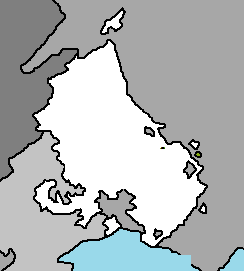Ossotia
Federation of Ossotia | |
|---|---|
|
Flag | |
 | |
| Capital | Tibliskana |
| Largest | Novyska |
| Government | |
| Sergei Yugorunov | |
| Population | |
• 2021 estimate | 5,431,000 |
The Federation of Ossotia, known commonly as Ossotia, is a nation in southern Ausiana bordered by Beleroskov and Skarmia, with a coast on the Beleroskov Sea and four enclaves within Beleroskov. It has a population of 5.2 million people. Its capital is Tibliskana and its largest city is Novyska, and it is led by President Sergei Yugorunov. It is a member state of the Coalition of Crown Albatross. Ossotia was a part of the United Communist and Socialist States (UCSS) from 1912 until 1982 when it declared independence. The UCSS led an invasion of Ossotia in 1983 to try and retain Ossotia within the union. The war lasted until 1984 and resulted in the deaths of over 100,000 people, significantly shifting Ossotia's demographics.
Since declaring independence in 1983, only four people have led the country; Yugov Olegovich (1983-91), Ikovle Lebedinsky (1991-2005), Kosheleva Manka (2005-2022), and Sergei Yugorunov (2022-present). Manka, as did his predecessors, headed an authoritarian government with a poor human rights record due to widespread abuses. Manka was ousted by the military on May 6th, 2022, and Sergei Yugorunov took power. Ossotia, Yuan and Beleroskov signed a treaty for greater cooperation, joining the Alliance of Central and West Ausianan Cooperation. Ossotia is a developing country.
History
Geography
Ossotia is bordered to the north and east by Beleroskov and to the west by Skarmia, with a southern coast along the Beleroskov Sea. Ossoita has four enclaves within Beleroskov, and Beleroskov has five enclaves within Ossotia. Ossotia also administers several dozen islands in the Beleroskov Sea, most of which are rocky outcroppings.
Geographically, Ossotia is located in 3 natural landscape zones: the forest zone to the north (coniferous and broad-leaved forests), the basis of which is pine-oak forests, pine forests and broad-leaved forests with the participation of oak and maple. Spruce occasionally joins them. Areas of the southern taiga are found on the coast of the region. The forest-steppe zone occupies the central regions of the region and is represented by a combination of areas of broad-leaved forests, most often oak and meadow steppes. Red deer, roe deer, elk, and sometimes bears are found in these forests. The south of the region is occupied by steppes consisting of typchak and sagebrush.